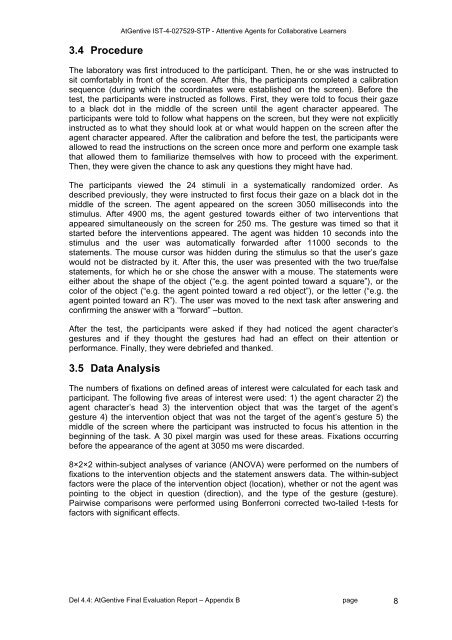Deliverable 4.4 - INSEAD CALT
Deliverable 4.4 - INSEAD CALT
Deliverable 4.4 - INSEAD CALT
Create successful ePaper yourself
Turn your PDF publications into a flip-book with our unique Google optimized e-Paper software.
3.4 ProcedureAtGentive IST-4-027529-STP - Attentive Agents for Collaborative LearnersThe laboratory was first introduced to the participant. Then, he or she was instructed tosit comfortably in front of the screen. After this, the participants completed a calibrationsequence (during which the coordinates were established on the screen). Before thetest, the participants were instructed as follows. First, they were told to focus their gazeto a black dot in the middle of the screen until the agent character appeared. Theparticipants were told to follow what happens on the screen, but they were not explicitlyinstructed as to what they should look at or what would happen on the screen after theagent character appeared. After the calibration and before the test, the participants wereallowed to read the instructions on the screen once more and perform one example taskthat allowed them to familiarize themselves with how to proceed with the experiment.Then, they were given the chance to ask any questions they might have had.The participants viewed the 24 stimuli in a systematically randomized order. Asdescribed previously, they were instructed to first focus their gaze on a black dot in themiddle of the screen. The agent appeared on the screen 3050 milliseconds into thestimulus. After 4900 ms, the agent gestured towards either of two interventions thatappeared simultaneously on the screen for 250 ms. The gesture was timed so that itstarted before the interventions appeared. The agent was hidden 10 seconds into thestimulus and the user was automatically forwarded after 11000 seconds to thestatements. The mouse cursor was hidden during the stimulus so that the user’s gazewould not be distracted by it. After this, the user was presented with the two true/falsestatements, for which he or she chose the answer with a mouse. The statements wereeither about the shape of the object (“e.g. the agent pointed toward a square”), or thecolor of the object (“e.g. the agent pointed toward a red object”), or the letter (“e.g. theagent pointed toward an R”). The user was moved to the next task after answering andconfirming the answer with a “forward” –button.After the test, the participants were asked if they had noticed the agent character’sgestures and if they thought the gestures had had an effect on their attention orperformance. Finally, they were debriefed and thanked.3.5 Data AnalysisThe numbers of fixations on defined areas of interest were calculated for each task andparticipant. The following five areas of interest were used: 1) the agent character 2) theagent character’s head 3) the intervention object that was the target of the agent’sgesture 4) the intervention object that was not the target of the agent’s gesture 5) themiddle of the screen where the participant was instructed to focus his attention in thebeginning of the task. A 30 pixel margin was used for these areas. Fixations occurringbefore the appearance of the agent at 3050 ms were discarded.8×2×2 within-subject analyses of variance (ANOVA) were performed on the numbers offixations to the intervention objects and the statement answers data. The within-subjectfactors were the place of the intervention object (location), whether or not the agent waspointing to the object in question (direction), and the type of the gesture (gesture).Pairwise comparisons were performed using Bonferroni corrected two-tailed t-tests forfactors with significant effects.Del <strong>4.4</strong>: AtGentive Final Evaluation Report – Appendix B page 8
















